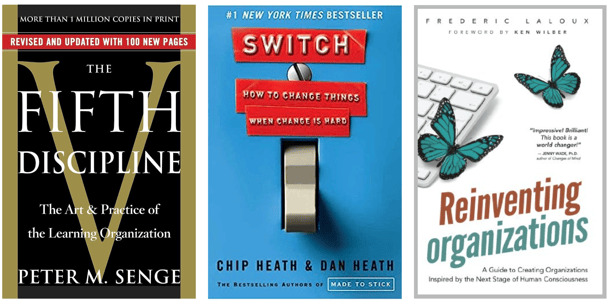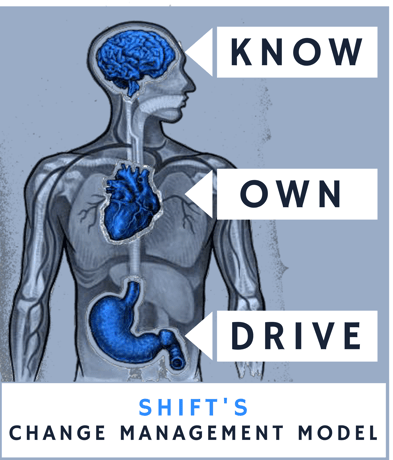
Last week I met with another CEO struggling with the pains and pace of change.Mark, the CEO of a thriving company, constantly grapples with the demands of a rapidly changing corporate landscape. Despite his best efforts, he can't unite his team, keep up with the change, or build a best-in-class hybrid organization.
With 4+ months left in 2023, he is trying to finish the year strong, begin to plan for 2024, and use the next few all-hands meetings to create momentum - the kind of momentum that is really difficult to create in Zoom.
And yet… The pressure from the board and shareholders is unrelenting, creating massive stress, anxiety, and the feeling of being perpetually behind the curve. He doesn't want to micromanage or dictate his team's every move but feels compelled to take control to ensure success.
Sound familiar? Mark's story isn't unique. Many CEOs face similar challenges in today's constantly evolving business world. How can leaders drive change without stifling creativity or encountering resistance?
The Necessity of Change Management
John Kottler, the grandfather of change management, famously said that 70% of change initiatives fail… and this was BEFORE the pandemic. In this era of disruption and exponential change, managing change isn't just a luxury—it's a necessity. It requires a deep understanding of organizational dynamics, human behavior, and strategic integration.
And the problem is: what got you here isn’t going to be what gets you there.
The Origins of Change Management
Did you know that you can get a PhD in Organizational Development and Change or Industrial-Organizational Psychology? Most of us have no idea that there is an entire academic track and history for managing change and studying human behaviors within organizations.
Here’s a brief history of change management and how we got to where we are today:
Change management emerged as a formal discipline in the early-to-mid 20th century, driven by the turmoil of World Wars, the industrial revolution, and rapid technological advancements.
Early pioneer Kurt Lewin recognized the importance of human behavior in change and developed the 'Unfreeze-Change-Refreeze' model, which remains a cornerstone of change management.
If you want to double click on the history and context, check out “The 5th Discipline” by Peter Senge.
The study of human psychology is closely linked to change management. The human brain has a natural resistance to change, and overcoming this resistance is crucial to successful change management. Leaders must understand the psychology of their employees to effectively manage change. The best book on this topic is "Switch" by Chip and Dan Heath.
As organizations evolved, so did the discipline. Change management went from academic theory to a practical tool integrated into businesses' strategic frameworks. The 21st century saw it evolve into a dynamic field encompassing a range of strategies to manage change. A book that puts this all together is, ”Reinventing Organizations” by Frederic LaLoux.
.And I love books, to the point where I have read more than a thousand of them. And business books dispensing guidance are not hard to find.

-SIDE RANT-
Success is traditionally viewed as a result of following certain rules and conventions, and these books go to great lengths to codify success. Do this to get promoted, do that to get a raise. From dressing a certain way to using specific language to get what you want, we’re often taught that sticking to the norm is the best and safest way to succeed. A quick search for business books on Amazon will provide 60,000 listings, all of which tell the reader what to do next.
My belief is that most of the advice you’ll find in these books is useless. Why? Because human beings can be arrogant as fuck. The moment we believe we’ve arrived and found the right way, we become fixated on the path we took as the only path possible—and we begin to tell others this is the right path for them and everyone else. For those on the receiving end of this advice, it’s all too easy to accept as truth because we are looking for that next-delivery, quick-fix solution. Whether we like to admit it or not, we’re used to being told what to do (and we might even like it that way). This is a holdover from our childhoods. Parents, teachers, and church leaders were happy to tell us what to do and how to do it. So, when we attain a position of power or prestige, we repeat the same pattern.
(rant over - thanks for listening)
Key Change Management Frameworks
Academic and industry-specific frameworks are crucial for understanding and implementing change management. Here are some top frameworks:
- Kotter's 8-Step Change Model: John Kotter's eight-step model for change implementation.
- ADKAR Model: Jeff Hiatt's five-building block model – Awareness, Desire, Knowledge, Ability, and Reinforcement.
- McKinsey 7S Model: A comprehensive framework that suggests the alignment of seven interrelated factors for organizational change.
- Lewin's Change Management Model: As mentioned, Kurt Lewin's model – Unfreeze, Change, Refreeze.
- Bridges' Transition Model: A model focusing on the transitions that accompany change, emphasizing the emotional and psychological responses.
- SHIFT The Work: developed using the latest neuroscience research, 600+ client engagements and more than 1MM+ survey data points, focusing on how to get someone to move from apathetic to all-in using their head, heart and gut.
We’re clearly standing on the shoulders of giants who came before us and did the very best they could with the information they had at the time.
What we have found is that the big guys—McKinsey, Bain & Company, Boston Consulting Group, Deloitte, Accenture for example - don’t love change work because it has little margin. And one-off consultants lack the bandwidth and lived experience to pull it off.
Helping leaders and organizations thrive through exponential change is what we live for and why we’ve existed for the past 23 years.

Avoiding the Pitfalls of Change Management
The road to hell is paved with good intention and despite these good intentions, leaders often fail when it comes to managing change.
The biggest assumptions executives make:
#1 – They heard you
#2 – They understand you
#3 – They are going to take action
"The single greatest illusion is that communication has taken place."
- my favorite quote from George Bernard Shaw
In addition to making bad assumptions, executives often make mistakes that have a big impact:
- Lack of a clear vision: Teams become confused and directionless without clarity.
- Ignoring the human element: Overlooking emotional and psychological aspects can doom initiatives *more on this later!
- Inadequate communication: Insufficient or inconsistent communication exacerbates divisions.
- Complacency: Initial success doesn't mean the job is done. Change requires sustained attention.
- Lack of buy-in: Stakeholders need to have a stake in the outcome.
The Cost of Poor Change Management
The stakes are high when it comes to navigating change and include significant consequences for not managing it well. In short - it’s costly.
Failure Rates: 70% of change efforts fail to achieve their goals, leading to wasted resources and lost opportunities (Source: McKinsey).
Engagement: Highly engaged teams are 21% more profitable, emphasizing the importance of keeping employees engaged during change (Source: Gallup)
Innovation Impact: 56% of CEOs believe innovation drives revenue growth, underscoring the cost of stifling creativity during change (Source: PwC).
Change Readiness: Projects with excellent change management are 6X more likely to meet objectives than those with poor change management (Source: Prosci).
Embracing Change and Shaping the Future
"If it doesn’t challenge you, it won’t change you."
Change can be hard and uncomfortable, but it is also an opportunity for growth and transformation. In working with 600+ clients over the past 22 years, we've learned that every moment counts and every touch point matters.
We encourage our clients to be willing to take risks, dream bigger, and drive change faster - all while enjoying the ride. By listening to their heart and gut as much as their head, they can transform themselves, inspire others, and achieve amazing things.
Reimagining the Organizational Pyramid & Control
Historically, organizations have been structured like pyramids, with a few voices at the top that matter and the majority below simply following orders. This model is outdated and dangerous.
Today's employees seek purpose, a say in the narrative, psychological safety, and the assurance that their voices matter.
To reimagine the organizational pyramid, start here:
- Treat Employees as Adults: Acknowledge employees want to do a good job and yearn for meaningful work, respect, and recognition.
- Embrace Freedom within a Framework: Focus on how work is done rather than where. Tap into the ingenuity of your people.
- Create Meaningful Incentives: Offer incentives that give people an upside, a stake in the outcome, and skin in the game.
- Define What Good Looks Like: Ensure your team knows what constitutes success and continuously reassess the criteria.
- Make it Worth It: Recognize employees invest their time, energy, attention, and focus in your organization, and make it worthwhile for them.
Do these things and you’re bound to create more authenticity, creativity, connection, and belonging where the voices of all matter.
What’s the difference at SHIFT, that makes the difference?
The Human Side of Change
One of the most overlooked aspects of change management is the human side. The reality is change is about people. People drive change, and people are impacted by change. Successful change management takes into account the emotions, behaviors, and attitudes of employees, ensuring they are engaged, motivated, and committed to the change.
The Power of Co-Creation
Involving employees in the change process is critical. Leaders who co-create solutions with their teams achieve greater buy-in and long-lasting change. We advocate for a participatory approach, where all voices are heard, and employees feel a sense of ownership in the change.
Leading with Empathy and Authenticity
Successful change leaders are empathetic and authentic. They understand the concerns and anxieties of their teams and address them with sincerity. By modeling vulnerability and openness, they create an atmosphere of trust and transparency.
Measuring Success Beyond the Bottom Line
Change management success should not be measured solely in financial terms - but by the impact on employee morale, team cohesion, customer satisfaction, and other intangible factors. These elements are crucial indicators of long-term success and organizational health.
A Future-Ready Organization
Change is inevitable. The key to success lies in building an organization that can adapt and thrive in an ever-changing business landscape. At SHIFT, we believe in empowering leaders and teams to be future-ready, with the skills, mindset, and tools to embrace change with confidence and resilience.
The SHIFT Approach
We'd love to show you how we're combining traditional change management proven methodologies and best practices with technology to shorten the change curve - no matter what change you're driving - and more importantly make that change last.
We partner with daring leaders, those willing to challenge norms, push boundaries, and redefine what's possible in work and life. We're not here to tell you what's best. Instead we're here to help you cut through the noise, tune into your own genius, make bold moves, and drive the change you need to win.
Landing the Plane
"The greatest danger in times of turbulence is not the turbulence – it is to act with yesterday’s logic." - Peter Drucker
In this era of exponential change, we must break free from old paradigms and embrace a new approach to change management.
At SHIFT, we are committed to helping leaders and organizations navigate change with agility, resilience, and success. By valuing the human side of change, creating a culture of continuous improvement, leading with empathy and authenticity, measuring success holistically, and building future-ready organizations, we can create a better, brighter future for all.
Let us journey together on this path of transformation, embracing change with open hearts and minds, creating structures that foster growth and collaboration, and shaping a better future where creativity, connection, and innovation thrive.
Let's SHIFT ourselves, our work, and our world.
Remember, change is not an event; it's a process. Embrace the journey.







